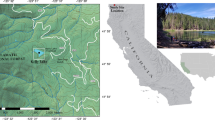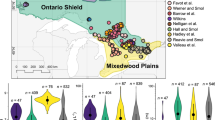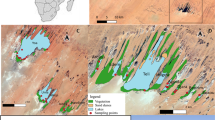Abstract
Weighted averaging (WA) regression and calibrationbased optima and tolerances of lakewater pH andtemperature are presented for diatoms in ecologicallysensitive, subarctic Fennoscandian lakes. The studysites are mostly small, simple, oligotrophic,low-conductivity lakes with a pH range from 5.0 to7.7 and a temperature range (after data screening)from 9.3 to 15.0 °C. Experiments with inverse andclassical deshrinking, with or without tolerancedownweighting, were used to identify the bestcalibration functions. The model estimates wereadjusted by jackknifing procedures. WA by inversedeshrinking and with tolerance downweighting performedbest for pH prediction, whereas simple WA wasmarginally superior for predicting water temperature.The established pH model is accurate to within± 0.39 H units, and the temperature model towithin ± 0.88 degrees Celcius. Fifteen diatom taxawere identified as potential indicator species for pHand three for temperature.
Similar content being viewed by others
References
Atlas of Finland, 1986. Appendix 132, water. National board of survey & Geographical society of Finland, 31 pp.
Anderson, N. J., 1993. Natural versus anthropogenic change in lakes: the role of the sediment record. Trends Ecol. Evol. 8: 356–361.
Battarbee, R. W., 1991. Recent palaeolimnology and diatom-based environmental reconstruction. In Shane, L. C. & E. J. Cushing (eds), Quaternary Landscapes. Belhaven Press, London: 129–174.
Bennion, H., S. Juggins & N. J. Anderson, 1996. Predicting epilimnetic phosphorus concentrations using improved diatom-based transfer function and its application to lake eutrophication management. Envir. Sci. Technol. 30: 2004–2007.
Birks, H. J. B., 1996. Contributions of Quaternary palaeoecology to nature conservation. J. veg. Sci. 7: 89–98.
Birks, H. J. B., J. M. Line, S. Juggins, A. C. Stevenson, & C. F. J. ter Braak, 1990. Diatoms and pH reconstructions. Phil. Trans. r. Soc. Lond. B 327: 263–278.
Charles, D. F., 1985. Relationship between surface sediment diatom assemblages and lakewater characteristics in Adirondack lakes. Ecology 66: 994–1011.
Charles, D. F. & J. P. Smol, 1994. Long-term chemical changes in lakes: quantitative inferences from biotic remains in the sediment record. In Baker, L. (ed.), Environmental chemistry of lakes and reservoirs. Advances in Chemistry Series 237. Washington, DC: American Chemical Society: 3–31.
Charles, D. F., J. P. Smol & D. R. Engstrom, 1994. Paleolimnological approaches to biological monitoring. In Loeb, S. L. & A. Spacie (eds), Biological monitoring of aquatic systems. Boca Raton, FL: CRC Press: 233–293.
Dixit, S. S., J. P. Smol, J. C. Kingston & D. F. Charles, 1992. Diatoms: Powerful indicators of environmental change. Envir. Sci. Technol. 26: 23–33.
Dixit, S. S., B. F. Cumming, H. J. B. Birks, J. P. Smol, J. C. Kingston, A. J. Uutala, D. F. Charles & K. E. Camburn, 1993. Diatom assemblages from Adirondack lakes (New York, USA) and the development of inference models for retrospective environmental assessment. J. Paleolimnol. 8: 27–47.
Dixit, S. S. & J. P. Smol, 1994. Diatoms as indicators in the Environmental Monitoring and Assessment Program-Surface Waters (EMAP-SW). Envir. Monit. Assess. 31: 275–306.
Douglas, M. S. V., J. P. Smol & W. Jr. Blake, 1994. Marked post-18th century environmental change in high arctic ecosystems. Science 266: 416–419.
Efron, B., 1982. The jacknife, the bootstrap and other resampling plans. Monogr. 38. Philadelphia, Pennysylvania Society for industrial and applied mathematics.
Haila, Y., 1992. Measuring nature: quantitative data in field biology. In Clarke, A. E. & J. H. Fujimura (eds), The Right Tools for the Job–At Work in Twentieth Century Life Sciences. Princeton University Press, Princeton, NJ: 233–253.
Hall, R. I. & J. P. Smol, 1996. Paleolimnological assessment of long-term water-quality changes in south-central Ontario lakes affected by cottage development and acidification. Can. J. Fish. aquat. Sci. 53: 1–17.
Hartley, B., 1986. Acheck-list of the freshwater, brackish andmarine diatoms of the British Isles and adjoining coastal waters. J. mar. biol. Ass. 66: 531–610.
Hill, M. O., 1973. Diversity and evennes: a unifying notation and its consequences. Ecology 54: 427–432.
Hustedt, F., 1957. Die Diatomeenflora des Hubsystems der Weser im Gebiet der Hansestadt Bremen. Abh. Naturw. Ver. Bremen 34: 181–440.
Huttunen, P. & J. Turkia, 1990. Surface sediment diatom assemblages and lake acidity. In Kauppi, P., P. Anttila & K. Kenttämies (eds), Acidification in Finland. Springer-Verlag, Berlin/Heidelberg: 995–1008.
Jones, V. J. & S. Juggins, 1995. The construction of a diatom-based chlorophyll atransfer function and its application at three lakes on Signy Island (maritime Antartic) subject to differing degrees of nutrient enrichment. Freshwat. Biol. 34: 433–445.
Juggins, S. & C. J. F. ter Braak, 1992. CALIBRATE–a program for species-environment calibration by [weighted averaging] partial least squares regression. Environmental Change Research Centre, University of Collage London.
Korhola, A., 1996. Northern lakes as key witnesses for climatic change. Universitas Helsingiensis 3: 16–19.
Korhola, A. & T. Blom, 1996. Marked early 20th century pollution and the subsequent recovery of Töölö Bay, central Helsinki, as indicated by subfossil diatom assemblage changes. Hydrobiologia 341: 169–179.
Korhola, A., J. Virkanen, M. Tikkanen & T. Blom, 1996. Fireinduced pH rise in a naturally acid hill-top lake, southern Finland: a palaeoecological survey. J. Ecol. 84: 257–265.
Korsman, T. & H. J. B. Birks, 1996. Diatom-based water chemistry reconstructions from northern Sweden: a comparison of reconstruction techniques. J. Paleolimnol. 15: 65–77.
Martens, H. & T. Naes. 1989. Multivariate Calibration. John Wiley, Chichester.
Moser, K. A., G. M. MacDonald & J. P. Smol, 1996. Applications of freshwater diatoms to geographical research. Progr. Phys. Geogr. 20: 21–52.
Mölder, K. & R. Tynni, 1973. Über Finnlands rezente und subfossile Diatomeen VII. Bull. Geol. Soc. Finland 45: 159–179.
Oksanen, J., E. Läärä, P. Huttunen & J. Meriläinen, 1988. Estimation of pH optima and tolerances of diatoms in lake sediments by the methods of weighting averaging, least squares and maximum likelihood, and their use for predicton of lake acidity. J. Paleolimnol. 1: 39–49.
Olander, H., A. Korhola & T. Blom, 1996. Surface sediment Chironomidae (Insecta: Diptera) distributions along an ecotonal transect in subarctic Fennoskandia: developing a tool for palaeotemperature reconstructions. J. Paleolimnol. (in press)
Patrick, R. & C. Reimer, 1966. The Diatoms of United States. Vol 1: Fragilariaceae, Eunotiaceae, Achnanthaceae, Naviculaceae. The Academy of Natural Sciences of Philadelphia, Philadelphia, 688 pp.
Patrick, R. & C. Reimer, 1975. The Diatoms of United States. Vol 2: Entomoneidaceae, Cymbellaceae, Gomphonemaceae, Epithemiaceae. The Academy of Natural Sciences of Philadelphia, Philadelphia, 213 pp.
Pienitz, R. & J. P. Smol, 1993. Diatom assemblages and their relationship to environmental variables in lakes from the boreal forest-tundra ecotone near Yellowknife, Northwest Territories, Canada. Hydrobiologia 269/270: 391–404.
Pienitz, R., J. P. Smol & H. J. B. Birks, 1995. Assessment of freshwater diatoms as quantitative indicators of past climatic change in the Yukon and Northwest Territories, Canada. J. Paleolimnol. 13: 21–49.
Reynolds, C. S., 1990. Temporal scales of variability in pelagic environments and response of phytoplankton. Freshwat. Biol. 23: 25–53.
Salonen, K., 1979. A versatile method for the rapid and accurate determination of carbon by high temperature combustion. Limnol. Oceanogr. 24: 177–183.
Seppä, H., 1996. Post-glacial dynamics of vegetation and tree-lines in the far north of Fennoscandia. Fennia 174: 1–96.
Smol, J. P., 1992. Paleolimnology: An important tool for effective ecosystem management. J. Ecosystem Health 1: 49–58.
Smol, J. P., 1995. Paleolimnological approaches to the evaluation and monitoring of ecosystem health: providing a history for environmental damage and recovery. In Rapport, UJ. D., C. L. Gaudet & P. Calow (eds), Evaluating and Monitoring the Health of Large-ScaleEcosystems.NATO ASI Series 128. Springer-Verlag, Berlin, Heidelberg: 301–318.
Smol, J. P., I. R. Walker & P. R. Leavitt, 1991. Paleolimnology and hindcasting climatic trends. Verh. int. Ver. Limnol. 24: 1240–1246.
Stevenson, A. C., S. Juggins, H. J. B. Birks, D. S. Anderson, N. J. Anderson, R.W. Battarbee, F. Berge, R. B. Davis, R. J. Flower, E. Y. Haworth, V. J. Jones, J. C. Kingston, A. M. Kreiser, J. M. Line, M. A. R. Munro & I. Renberg, 1991. The surface waters acidification project palaeolimnology programme: modern diatom/lake-water chemistry data-set. ENSIS Publishing, London, 86 pp.
ter Braak, C. J. F., 1986. Canonical correspondence analysis: a new eigenvector method for multivariate direct gradient analysis. Ecology 67: 1167–1179.
ter Braak, C. J. F., 1988. CANOCO–FORTRAN program for canonical community ordination by [partial] [detrended] [canonical] correspondence analysis, principal components analysis and redundancy analysis (version 2.1). TNO Institute of Applied Computer Sciences, Wageningen, 95 pp.
ter Braak, C. J. F., 1990. Update notes: CANOCO version 3.10. Wageningen: Agricultural Mathematics group, 35 pp.
ter Braak, C. J. F., 1994. Canonical community ordination. Part I: Basic theory and linear methods. Écoscience 1: 127–140.
ter Braak, C. J. F. & C. W. N. Looman, 1986. Weighted averaging, logistic regression and the Gaussian response model. Vegetatio 65: 3–11.
ter Braak, C. J. F. & H. Van Dam, 1989. Inferring pH from diatoms: a comparison of old and new calibration methods. Hydrobiologia 178: 209–223.
ter Braak, C. J. F. & S. Juggins, 1993. Weighted averaging partial least squares regression (WA-PLS): an improved method for reconstructing environmental variables from species assemblages. Hydrobiologia 269/270: 485–502.
Tynni, R., 1975–80. Über Finnlands rezente und subfossile Diatomeen. Geol. Surv. Finland, Bulletins Vols 274: 1–55; 284: 1–37; 296: 1–55; 312: 1–93.
Weckström, J., A. Korhola & T. Blom, 1997. The relationship between diatoms and water temperature in 30 subarctic Fennoscandian lakes. Arct. Alp. Res. 29: 75–92.
Author information
Authors and Affiliations
Rights and permissions
About this article
Cite this article
Weckström, J., Korhola, A. & Blom, T. Diatoms as quantitative indicators of pH and water temperature in subarctic Fennoscandian lakes. Hydrobiologia 347, 171–184 (1997). https://doi.org/10.1023/A:1003091923476
Issue Date:
DOI: https://doi.org/10.1023/A:1003091923476




